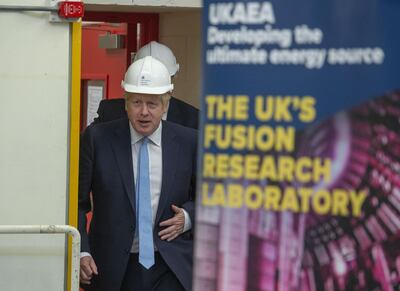For some it’s the ultimate source of clean energy, capable of saving the world from catastrophe. For others, it’s just a scientific pipe dream that will never deliver on its promise.
What’s not in doubt is that nuclear fusion is an incredibly potent source of energy that has powered the sun and stars for billions of years. Just a cubic metre of fuel – which can be extracted from sea-water – could power 10 million homes for a year.
The question is whether this literally stellar power source can ever be made commercially viable.
Last month, the International Atomic Energy Agency (IAEA) brought fusion experts from around the world to Moscow to compare notes on progress towards answering that question.
The meeting comes amid intense pressure on governments to find viable alternatives to fossil fuels that could make the global economy carbon-neutral.
For more than half a century, nuclear fusion has been touted as the ideal answer. Its hydrogen-like fuel is available in virtually limitless quantities, it produces no greenhouse gases or long-term radioactive waste and carries no risk of meltdown.
That list of benefits is now attracting political attention. British Prime Minister Boris Johnson recently pledged to spend £200 million towards building a viable fusion power plant “by 2040”.
But for many scientists it was a pledge that recalled an old joke: “Nuclear fusion is 30 years away - and always will be”.
The joke reflects the seemingly endless quest to solve the challenge of bringing the power-source of the stars down to earth.

Despite its name, nuclear fusion is fundamentally different from conventional nuclear power. Instead of splitting apart atoms of heavy elements such as uranium to release energy, nuclear fusion smashes atoms of light elements like hydrogen together so hard they fuse together, unleashing far more energy in the form of fast-moving particles.
Slamming into special “blankets” wrapped around the fusion machine, these particles dump their energy as heat, which is then used to generate electricity like a supercharged conventional power station.
But while the science is relatively straightforward, achieving fusion is anything but. Stars manage it by virtue of being huge, their own intense gravity creating the colossal pressures and temperatures needed to persuade the atoms to fuse.
Doing the same on earth is far harder. It requires a machine capable of heating fuel to temperatures in excess of 100 million deg C, and then gripping it safely and reliably while energy pours out of it.
Such temperatures were first achieved on earth in the early 1950s in the form of hydrogen bombs. It took another 20 years for scientists to agree a way of doing the same under controlled conditions.
The result was the so-called “tokamak”, a doughnut-shaped device which uses magnetic fields to hold and control the fusion fuel.
After another 20 years, scientists finally succeeded in triggering controlled fusion using one such machine, known as JET near Oxford, UK. It still holds the record for the amount of fusion power generated: 16 megawatts for just two seconds.
Even now, more than 20 years on from that record, the modest goal of achieving “breakeven” - getting more fusion energy out than is used to trigger the reactions - remains elusive.
Most scientists believe the best hope lies in ITER, the huge tokamak being constructed near Aix-en-Provence, France. But its completion date has slipped by over a decade to 2027, the price-tag has quadrupled to $20 billion - and even then it will never be commercially viable.
Getting there was the focus of the Moscow meeting, where scientists examined the challenges involved in building the kind of real-life fusion power station hoped for by Mr Johnson.
But while they may share his excitement about harnessing the power source of the stars, they all know they are nowhere near close to answering the key question: can fusion ever compete with conventional energy sources?
To judge by the long list of challenges addressed at the Moscow meeting, it would take almost pathological levels of optimism to think fusion can be economically viable any time soon.
After half a century of experiments, suitable materials for building a commercial fusion reactor remain elusive. Conventional materials like tungsten, a metal with the highest melting point, and carbon composite can take the heat, but they also interfere with fusion reactions.
Progress is being made on ways to protect the hottest parts of the reactor using liquid metals. Recent work suggests liquid lithium might work well, as it can both provide some shielding, and mop up stray particles that affect the fusion reactions. But the practicalities are far from being resolved.

Researchers are also looking at different fusion reactor designs. Conventional tokamaks use intense magnetic fields to control the fusion fuel, and these consume huge amounts of electricity.
So far, designers have tried to minimise the demand using so-called superconducting magnets, but these are still expensive to build and operate.
Now scientists at Princeton University in New Jersey are exploring a design of reactor which could use permanent magnets – the type similar to fridge magnets. Admittedly, those needed for fusion are far more sophisticated, but the basic advantage is the same: they don’t need electricity.
Far more radical approaches to fusion power are also being investigated by private sector start-ups, some backed by billionaires like Bill Gates and Jeff Bezos.
Most are aiming to find ways of triggering fusion in far smaller machines than ITER. Some of the ideas seem outlandish – like heating fusion fuel by crushing it with pistons. And so far, none of them have got close to achieving the conditions needed to generate fusion power.
Whether any of them will debunk that old joke about nuclear fusion power being forever 30 years away remains to be seen. But as the Earth warms up, it’s becoming increasingly clear that we may not have another 30 years to find out.
Robert Matthews is Visiting Professor of Science at Aston University, Birmingham, UK

